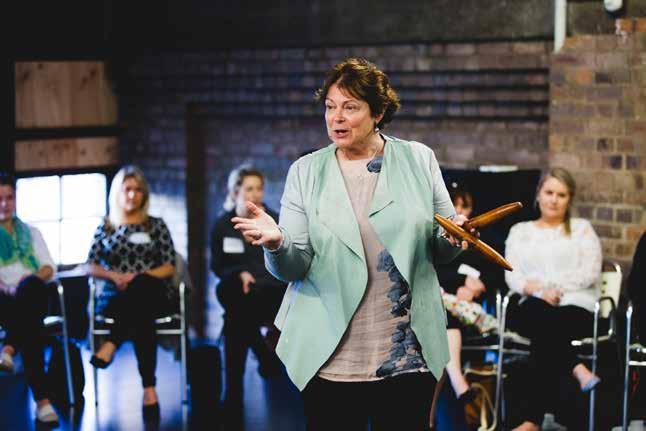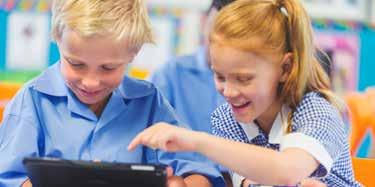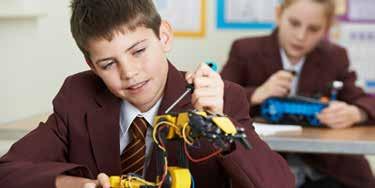
15 minute read
The tech effect
from IE #2 2020
by IEU NSW/ACT
Does every pair of hands in your classroom hold a digital
device? IE journalist Monica
Advertisement
Crouch hears all sides of the debate about technology’s impact on teaching.
“Kids and screen time” has long been a go-to topic at dinner parties throughout the nation. Now, thanks to Growing up Digital, a new report by the Gonski Institute for Education at the University of NSW, the discussion has shifted focus to technology in schools – and moved into the public domain.
The report, released in midApril 2020, is a groundbreaking exposé of the impact of educational and personal technologies in the classroom. It is based on a survey of 1876 teachers, principals and support staff from government, Catholic and independent schools, from preschool to Year 12, asking what they are observing as technology finds its way ever deeper into classrooms. It was a mission of discovery with some unsettling findings.
The Secretary of the NSW Department of Education, Mark Scott, was one of the first to weigh in. “Part of our challenge as educators is that this a realtime experiment that’s being conducted on us all,” Scott said in a Four Corners episode aired on 20 November 2019 (the program gained exclusive early access to initial survey results).
“It’s not as though we’re wise adults who can reflect on how we dealt with smartphones when we were children,” Scott said. “We’re learning to use the technology at the same time as we’re trying to train young people to use the technology.”
Professor Pasi Sahlberg, Deputy Director of the Gonski Institute and co-author of the report, says that with technology’s benefits come challenges to students’ wellbeing. “It is clear the problems facing young people today are complex,“ he said. “But simply banning devices will not help students navigate the digital minefield.“

Inevitable and essential
Let’s start with the good news. The survey revealed that “43 per cent of Australian teachers and principals believe digital technologies enhance their teaching and learning activities, rather than detract”.
Robyn Ewing AM, Professor Emerita, Teacher Education and the Arts at the University of Sydney (pictured top right), sees technology in the classroom as not just inevitable but essential.
“In the age we live in, childre n need to be literate in a whole range of different ways,” Professor Ewing said. “Today’s children are used to different forms of technology from a young age. All of those things are good and needed and necessary in the context in which we’re living.”
A kindergarten teacher from Sydney, Michelle Smith (not her real name, to protect the identity of her students), embraces technology herself and enjoys teaching it to her students. She aims to instil in her students a continual willingness to learn by modelling this herself.
Smith’s kindergartners have taken enthusiastically to Sphero and Bee-bots, programmable devices that move according to instructions entered into an iPad – a novel way for young brains to learn basic coding. Students at Smith’s school also get a taste of 3D printing and Micro:bit – pocket-size computers for
The tech effect P10 Closing the Gap - 2020 marks a new era P16

gaining digital skills. “They love anything that’s new,” Smith said. “As soon as we put the Sphero in front of them, their curiosity is like ‘wow’.”
The young pupils at Smith’s school not only teach technology how to do things, they are taught by it. Smith is a big fan of rED Writing, an app that teaches handwriting using the standard NSW font, and several others that target specific reading skills, such as diagraphs. When the coronavirus pandemic struck and the school needed to shift to online learning, Seesaw and Google Classroom entered the mix.
But isn’t all this technology encouraging passivity and physical inactivity? Smith has an app for that too: she gets her students moving to GoNoodle, which offers short exercise and dance videos that the children enjoy.
The write stuff
A teacher librarian in a Sydney high school, Greg Jones (not his real name) is reluctant to lay any social or learning issues in the classroom at the feet of technology. “I’m wary of automatically ascribing any problems to the digital age,” he said. “There are lots of students who struggle with writing, but that’s always been the case, and I don’t know that those problems can all be sheeted home to the digital age.”
Jones also sees the advantages of students having digital technology at their fingertips. “For research purposes, it’s brilliant – there is so much more material that students have access to in the digital environment,” he said, referring in particular to the State Library’s treasure trove of databases that enable senior students to conduct research without having to leave their desks. However, the sheer volume of material on offer can also overwhelm them. “It’s the challenge of plenty, rather than the challenge of want,” Jones said.
the professional voice of the Independent Education Union of Australia
In his classes, Jones adopts what he calls a “mixed approach”. Students take notes using pen and paper not laptops, but Jones sets homework to be completed on their devices and shared with him on Google Classroom. At his school, he says, “there wouldn’t be any classes with no digital interaction but nor would there be any classes where it’s solely digital interaction”.
Jones insists on students using pens in class to improve their handwriting for the HSC, which is still a written exam. But there’s another, perhaps more compelling, reason. “There’s research to suggest handwriting forges synaptic connections that typing doesn’t, especially when you’re summarising the material you’re writing, so you’re critically filtering material that’s coming to you,” he said. “So getting students to write by hand might improve their critical

thinking, and it can also improve their speed, which can be useful in the exams.”
Both Smith and Jones point out how technology helps students who have typically struggled. Smith says pupils from non-English speaking backgrounds “do really well” when they can participate in online activities alongside their classmates. Jones mentions a student with dyslexia for whom text-tovoice technology is a huge help.
Internet versus human interaction
Despite these advances, teachers and principals are also sounding the alarm about technology in the classroom. In March 2016, Sydney Grammar School made headlines when its then principal, John Vallance, banned laptops in class, saying they “distracted” from quality teaching. He decried the billions spent on computers in Australian schools as “a scandalous waste”.
Sydney Grammar students have access to computers in the school’s computer lab and they’re encouraged to use laptops at home – but not in class. By way of contrast, Smith describes her primary school as BYOD (bring your own device): parents of students in Years 4, 5 and 6 are encouraged to purchase a Chromebook for their child to bring in.
Not so Sydney Grammar. “We see teaching as fundamentally a social
activity,” Vallance said in The Australian. “It’s about interaction between people, about discussion, about conversation. We find that having laptops or iPads in the classroom inhibits conversation – it’s distracting.” He’d prefer to fund teaching staff not technology, he said.
Sydney Grammar’s current principal, Richard Malpass, agrees with his predecessor, expressing his scepticism about ubiquitous devices in a 2018 blog on the school’s website. “Laptops and iPads are powerfully engaging devices, but that does not in turn automatically amount to them being better tools for children to learn subject knowledge and develop cognitively progressive skills,” he wrote.
“We should remind ourselves that laptops, iPads and the like were not necessarily designed to further the profession of education.”
Malpass too emphasises the crucial relationship of teacher and student. “We should guard against the risk of losing focus on the essential qualities of a great classroom (whatever the century), and the core dynamic between a fine teacher and his or her students,” he wrote.

Meaningful communication
This vital dynamic between teacher and pupil, and even parent and child, is what Professor Ewing calls “meaningful communication” – and it is central to all learning. And learning to read, she says, is all about “meaning making”.
She also issues a wake-up call: children who are “babysat” by screens from a very early age start school with thousands fewer words in their vocabularies than children who have experienced meaningful communication.
“There are different kinds of online learning – some are interactive, some are passive, they are about sitting and listening, and there’s a time for that,” Professor Ewing said. “But there has to be time to ask questions, and to ask the big questions, not just the kind that get an instant answer. And there has to be a time for wondering, and talking about the questions for which there aren’t clear-cut answers.” Children absolutely need these “substantive conversations“ with teachers, parents and peers.
Professor Ewing emphasises the issue is not the technology itself, but how it is used. It is one thing for a student to spend several hours online researching and exchanging ideas with classmates, another altogether to spend it scrolling aimlessly through social media.
Smith also worries about parents avoiding meaningful conversations with their children, citing young parents in the local park who focus on their phones while their children play, and prams with brackets to hold iPads to keep toddlers, even babies, entertained. Professor Ewing recommends children under the age of one not have any screen time at all.

Fatigued and frustrated
Jones is keenly aware of tiredness among his tech-loving pupils who play online games late into the night. “It’s a really big issue with teenage boys of 15-plus,” he said. “It’s not confined to my school, but there are a number of students who struggle to complete homework – they’re tired during class time, and when I ask why, it’s because they’re playing games.”
A teacher who responded to the Growing up Digital survey expressed a different but no less disquieting concern about computer games: “Students seem to spend a large portion of the day thinking about the games they play at home during their classroom learning time, which impacts the focus they have on their learning.”
Smith notes that her kindergartners become frustrated if they cannot solve a technical issue instantly, and they quickly lose patience with login processes. “Their mood changes if they can’t do something or they don’t understand why it’s not working,” she said. Similarly, she says, teachers become frustrated when the internet is down, interrupting their lessons.


Empathy and the arts
Professor Ewing was not surprised to discover that 78 per cent of the respondents to the Growing up Digital survey noticed a decline in empathy among students.
As an antidote, she emphasises the role of literature and the creative arts in developing empathy. “We’ve got a lot of research now to show that the reading of imaginative fiction or story – you know, books – is really important for us in continuing to develop our empathy and compassion,” she said. “The more opportunities there are to focus on the imaginative and the fictional, the more that helps us understand ourselves as human beings and understand others.
“The more we can use art forms like drama and art and music and dance, which are all literacies in different ways, because they’re all about making meaning in different ways, the more we will be able to imagine different possibilities and different ways of making the world a better and more socially just place,” she said.
Professor Ewing is nonetheless aware that in the face of an online world that serves up constant colour and movement and novelty, engaging students in artistic processes is not necessarily easy. But she is optimistic. “All of us innately need the arts,” she said. “Slowing things down is important. It’s about less is more and about enabling us to use arts processes and experiences to look at the things we take for granted in the world in a different way. It’s not about the end product but the process.”
Jones says he is yet to meet a student who isn’t captivated by The Outsiders, the coming-of-age novel by S E Hinton, published in 1967. And he has paved a way into Shakespeare for his students through Pop Sonnets, in which author Erik Didriksen rewrites lyrics by the likes of Beyoncé, the Beatles, Taylor Swift and Queen in the style of Shakespearean sonnets. Initially released on Instagram, Pop Sonnets are a unique melding of Elizabethan literature and the digital age. They engender intense focus among Jones’s students, who compete to identify each song while simultaneously absorbing an important literary genre.
The results of this kind of learning are unequivocal, Professor Ewing says: students who are engaged in arts-rich processes get their social and emotional wellbeing fed, which in turn means they fare better academically – and not just in arts subjects, but in non-arts areas as well.
And once students gain vital critical thinking and literacy skills, she says, they can more effectively evaluate what they encounter on the internet. It follows that they are less likely to fall victim to the kinds of scams, conspiracy theories and “fake news” that have become increasingly prevalent online in the past five years.
Budget blues
While Smith is squarely among those who see technology as enhancing learning and teaching, she nonetheless worries about the financial pressure on both schools and parents. “Technology is changing all the time, and each time it becomes more expensive,” she said. Then there are the frustrating compatibility issues between the devices and operating systems used in the classroom and those the students have at home.
Some 83 per cent of teachers who responded to the Growing up Digital survey agree that socio-economic circumstances impact on access to educational technology. This was thrown into sharp relief during the recent shift to online learning as a result of the coronavirus. A family with three or four children, for example, cannot necessarily provide a laptop and/or iPad for each one.
The Growing up Digital report revealed another unsettling statistic. “Worryingly, 29 per cent of teachers have noticed an increase in the number of students coming to school hungry,” it said. “It is possible this could be an indicator of growing financial strain on families, perhaps in an effort to keep in step with the technological advances and expense of devices.”

Igniting interest
Through all this technological transformation and the reach of technology into the nation’s classrooms, two factors emerge as timeless. The first is the relationship between teacher and student that cannot be replicated by any technology.
Jones raises the quote often attributed to Irish poet W B Yeats: “Education is not the filling of a pail, but the lighting of a fire.” It is the role of the teacher, not technology, to ignite that fire. “If you can stimulate the curiosity of students, they will start to learn and teach themselves,” Jones said. “And I think that might be where the most productive learning is done, when it’s self-directed.”
The second is the importance of good old-fashioned books in the teaching and gaining of literacy. A self-described eBooks addict, Smith nonetheless believes in very young children experiencing books. “Don’t shove that thing in their faces!” she wants to say to parents who absent-mindedly hand devices to their children. “You’ve got to give them books and the experience of turning pages.”
Professor Ewing couldn’t agree more. “That’s one of the key indicators and key predictors of success: the amount of reading and the number of books in the home,” she said.
Stats at a glance • 43% of the surveyed Australian teachers and principals believe digital technologies enhance teaching and learning activities • 84% believe digital technologies are a growing distraction in the learning environment • 60% believe technology has positively impacted the learning experience for students with disabilities • 59% observed a decline in students’ overall readiness to learn in the past three to five years • 78% say students’ ability to focus on educational tasks has declined in the past three to five years • 83% agree that students’ socioeconomic circumstances impact on their access to the technology they need for school • 67% think the number of children arriving at school tired has increased • 80% see a decline in students’ empathy • 60% see a decline in physical activity. Source: Growing up Digital Australia, Gonski Institute for Education, 2020 Six tips for less tech • Encourage young children to read at least one book a month for pleasure • Encourage young children to handwrite a letter to a loved one every week • Get children to play outside after school away from the screens • Be a role model: be available, not on your own device • Take time to talk, tell stories, ask big questions and wonder together • Share the reading process: read to each other Source: Gonski Institute and Professor Robyn Ewing References Sahlberg, P. and Graham A., Growing up Digital: Phase 1, Technical Report, Gonski Institute for Education, University of NSW, April 2020: bit.ly/2WYVIO2 Four Corners, DigiKids: Why too many young Australians are struggling with literacy in the digital age, ABC, 20 November 2019: youtube.com/watch?v=zXWAIXy4oG4 also available on ABC iView Milligan, L. and Robinson, L., The first generations of ‘digikids’ are struggling with literacy as experts warn against screen time, ABC News, 20 November 2019: ab.co/2ZARBJP Ewing, R., Co-directer, CREATE Centre, (Creativity Research, Engaging the Arts and Transforming Education), The University of Sydney: bit.ly/3eh6ipy Malpass, R., The tweny-first century classroom – a reflection, Sydney Grammar School website, 24 January 2018: bit.ly/2LZg6IA Bita, N., Computers in class ‘a scandalous waste’: Sydney Grammar head, The Australian, 25 March 2016 Didriksen, E., Pop Sonnets, Quirk Books, 2015 Hinton, S. E., The Outsiders, Viking Press, 1967










